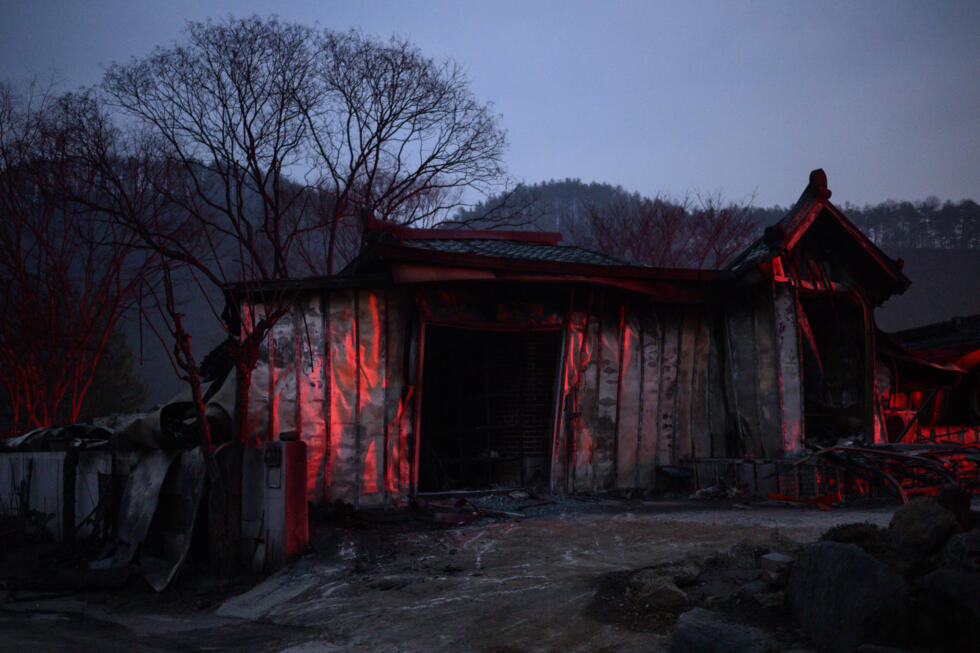News Flash
News Flash

YEONGDEOK (SOUTH KOREA), March 28, 2025 (BSS/AFP) - Overnight rain helped douse some of South Korea's worst-ever wildfires, authorities said Friday, as the death toll from the unprecedented blazes raging for nearly a week reached 28.
More than a dozen fires have ravaged large areas of the country's southeast, destroying an ancient temple, and forcing around 37,000 people to evacuate.
The wildfires blocked roads and knocked out communication lines, causing residents to flee in panic as fireballs rained down on cars stuck in traffic jams.
The flames have been fanned by high winds and ultra-dry conditions, with the area experiencing below-average rains for months after South Korea had its hottest year on record in 2024.
Lim Sang-seop, chief of the Korea Forest Service, said the main fire in North Gyeongsang province, which started around noon last Saturday, was extinguished on Friday afternoon.
It was the deadliest of several wildfires, killing 24 people.
Rain which started Thursday afternoon "reduced the haze, improving visibility, and the cooler temperatures compared to other days create very favourable conditions for firefighting efforts", Lim said.
South Korea's interior ministry said a total of 28 people had been killed as of Friday morning, and 37 others were injured -- nine seriously.
Most of the victims of the fire, which hit deeply rural Andong and Uiseong hardest, were "in their 60s and 70s", an official from the Korea Forest Service told AFP.
The country is grappling with a rapidly ageing society and regional disparities, as just over half of its population resides in the greater Seoul area, while the countryside struggles to attract younger generations.
The fatalities include a pilot in his 70s whose helicopter crashed Wednesday while he was trying to contain a fire, as well as four firefighters and other workers who lost their lives after being trapped by rapidly advancing flames.
- Hottest year in 2024 –
More than 2,240 houses in the region have been destroyed, according to the latest figures, and an official said Thursday more than 35,000 hectares (86,500 acres) of forest have been burned.
The extent of damage makes it South Korea's largest-ever wildfire, after an inferno in April 2000 that scorched 23,913 hectares across the east coast.
The fire also destroyed several historic sites, including the Gounsa temple complex in Uiseong, which is believed to have been originally built in the 7th century.
Among the damaged structures at the temple are two state-designated "treasures", one of which is a pavilion built in 1668 that overlooks a stream.
Last year was South Korea's hottest on record, although temperatures in the months running up to the blaze had been colder than last year and in line with the country's 30-year average, Korea Meteorological Administration data show.
But the fire-hit region had been experiencing unusually dry weather with below-average precipitation.
According to the interior ministry, the wildfires were accidentally started by a grave visitor and "sparks from a brush cutter".
- Unusually warm –
Some people have expressed concerns that rural communities were left to fend for themselves.
The governor of Yeongyang, where more than half of its 15,271 residents are aged 60 or older, issued a statement on Friday urging residents to help by clearing embers and looking after their neighbours.
Six of the 28 victims were from the ageing town. Governor Oh Do-chang said no helicopters had been deployed to the area over the past three days and urged the central government for more aid.
The devastating California wildfires in January and those in South Korea are similar, said Kimberley Simpson, a fellow in nature-based climate solutions at the University of Sheffield's School of Biosciences.
"Both were preceded by unusually warm, dry conditions that left vegetation highly flammable, and both were intensified by strong winds that spread the flames and hampered firefighting efforts," she said.
"Only three months into 2025, we've already witnessed record-breaking wildfire activity in multiple regions.
"As climate change drives rising temperatures and alters rainfall patterns, the conditions that give rise to these devastating fires are becoming more frequent."